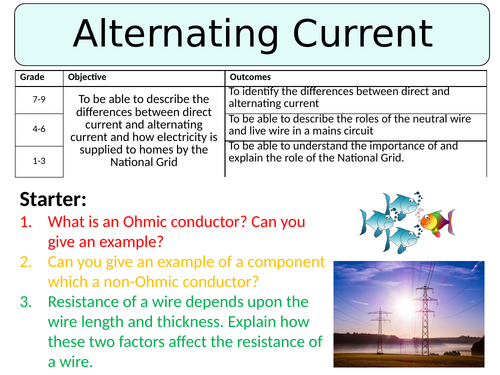
This lesson is designed for the NEW AQA Trilogy Physics GCSE, particularly the 'Electricity’ SoW.
For more lessons designed to meet specification points for the NEW AQA Trilogy specifications for Biology, Chemistry and Physics please see my shop: https://www.tes.com/teaching-resources/shop/SWiftScience
The lesson begins with an introduction to the differences between alternating and direct current, demonstrate with a diagram and a video. Students will then watch another video, using which they will answer a set of questions about alternating current, direct current and the use of oscilloscopes. Once this task has been completed students can self-assess their work using the mark scheme provided in the power point presentation.
The next task will require pupils to read a set of information about wiring within three-pin plugs before sketching a diagram of the plug and completing a table to summarise the colour and roles of the live, neutral and earth wires. Again, this work can be self-assessed using the mark scheme provided. Students will then need to sketch a diagram of an oscilloscope trace from an a.c. and d.c. supply and provide some notes about what these two traces are showing us.
The next part of the lesson will focus on the National Grid, firstly students will observe a simplified diagram of the route taken by an electric current from the power station to people’s homes, this route involves the electric current passing through a step-up and step-down transformer. Students will need to watch a video and then summarise the role of these two types of transformers. This task can be self-assessed against the answer provided in the PowerPoint presentation.
Next, the PowerPoint presentation explains why it is important to keep the voltage in the overhead cables very high and the current very low - to reduce resistance. Students will then need to complete a fill-in-the-blank task to sum up the main points about the National Grid.
The last part of the lesson will require pupils to observe oscilloscope traces for different a.c. supplies, firstly they will be shown how to work out the period, they will need to apply this to each oscilloscope trace. Then using the period, they will need to calculate the frequency for each trace - making sure they show all their working! Once this task is complete pupils can self or peer assess their work using the mark scheme provided.
The plenary task is an exit card, students are asked to write down three facts they have learned during the lesson, five key words and one question to test their peers knowledge.
All resources are included at the end of the presentation. Thanks for looking, if you have any questions please let me know in the comments section and any feedback would be appreciated :)
Get this resource as part of a bundle and save up to 58%
A bundle is a package of resources grouped together to teach a particular topic, or a series of lessons, in one place.
Something went wrong, please try again later.
This resource hasn't been reviewed yet
To ensure quality for our reviews, only customers who have purchased this resource can review it
Report this resourceto let us know if it violates our terms and conditions.
Our customer service team will review your report and will be in touch.
